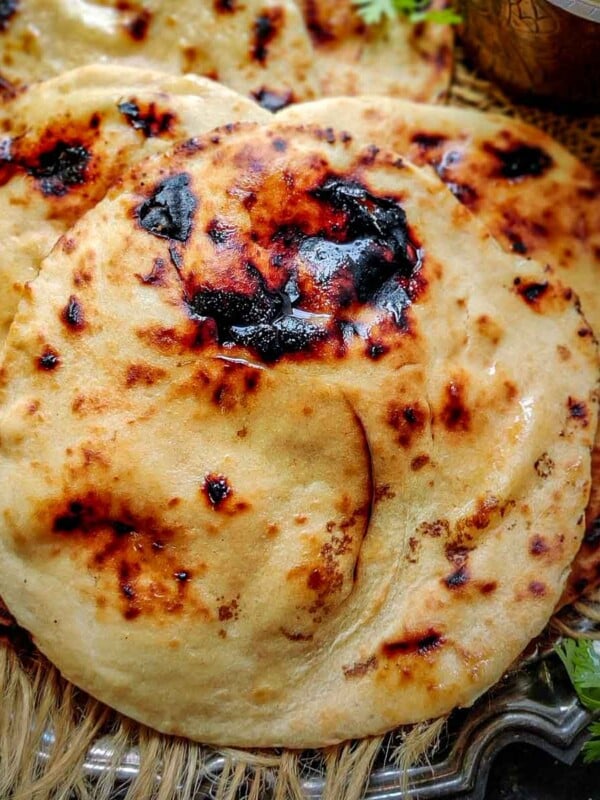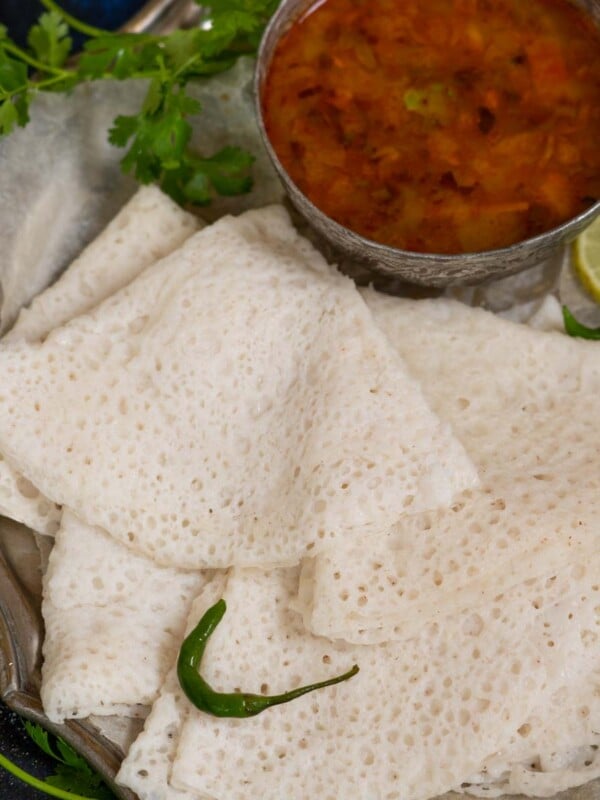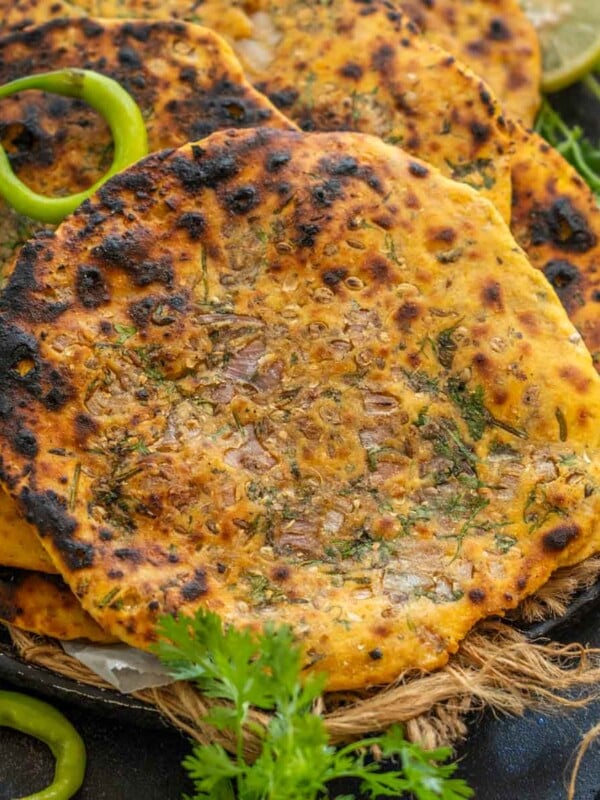Ajwain Paratha (Carom Seeds Flatbread)
on Nov 25, 2024, Updated Jan 08, 2025
Ajwain Paratha (Carom Seeds Flatbread) is an Indian flatbread prepared with whole wheat flour, carom seeds (ajwain), salt, and ghee. Serve it for breakfast with tea or coffee.
Here are a few more paratha recipes that you may like: Aloo Paneer Paratha, Schezwan Paneer Paratha, Chilli Cheese Paratha, and Masala Paratha.

For many North Indians, breakfast is some kind of paratha with pickle and yogurt (curd). It keeps you full for a long time and even if you have to skip lunch for some reason, you can easily survive the day.
I love eating garma garam (hot) parathas with chai and pickle. I make them often, especially when Mohit is travelling, as he is not a ‘Paratha for Breakfast’ person.
This Ajwain paratha, or paratha flavored with carom seeds is my favorite. Firstly because it is very easy and fuss-free to make and secondly because when made properly, it is very delicious.
About Ajwain Paratha
Ajwain means carom seeds in English. Ajwain Paratha (Ajwaini Paratha) is a classic Plain Tawa Paratha flavored with ajwain and salt.
Carom seeds give it a unique flavor, making it very delicious.
This flaky and soft paratha is quick to make using four simple ingredients. You can make it triangular, as I did, or roll it like a Lachha Paratha to make it extra indulgent.
It is best served with a pickle and Masala Chai for breakfast but can also be served with curries or dals.
Ingredients
Whole Wheat Flour (Gehu ka Atta) – Parathas are traditionally made using whole wheat flour. You can add a little all-purpose flour to make them flakier.
Multigrain flour can also be used to make this paratha.
Buy the flour from an Indian grocery store for the perfect paratha texture. My favorite brands are Aashirwad Whole Wheat Atta or Sujata Gold Sharbati Wheat Flour.
Ajwain, also called carom seeds, is this recipe’s star ingredient. It is good for the stomach, helps digestion, and adds a unique flavor to the paratha. You will get it in an Indian grocery store or on online portals like Amazon.
Read more about its health benefits here.
Ghee – Adding a little ghee to the dough makes the paratha soft. To make vegan paratha, replace ghee with oil.
Salt – It adds flavor to the ajwaini paratha.
Oil or Ghee – You will need oil or ghee to cook the ajwain paratha. Use canola oil, light olive oil, or any other cooking oil that you like.
How To Make Carom Seeds Paratha
Make The Dough
Add the following ingredients to a large bowl (or parat).
- 2 cups of whole wheat flour
- 1 teaspoon ghee
- 1 teaspoon salt
- 3 teaspoon of ajwain

Mix well using your fingers until a crumbly mixture is made. This process also rubs the ajwain and it releases its flavor in the flour.

Add water little by little (approx ½ cup) and knead to make a soft dough. Do not add water in one go otherwise the dough can become sticky.


Cover the dough with a kitchen cloth and keep it aside for 30 minutes.

Roll The Paratha
Heat a griddle (tawa) over medium heat.
Knead the dough once again for 10 seconds and divide it into 8-9 equal parts.
Roll each part to make smooth balls.
Take one ball and keep it on a flat surface. You can use a rolling board (chakla) or your kitchen counter.
Note – Keep the remaining balls covered to prevent them from drying out.

Dust the dough ball with some dry flour and roll using a rolling pin to make a 4-inch circle.

Brush oil on the circle and fold the sides to make a semi-circle.


Brush oil again and then fold to make a triangle.


Dust with dry flour and roll again to make a 5-inch triangle. The paratha should not be as thin as the roti. It should be a little thick. The sides should be thinner than the center.

Cook The Paratha
Transfer the paratha to the hot griddle (tawa).

Cook until brown spots appear on the bottom side.
Flip and brush 1 teaspoon oil all over.
Flip again and brush another teaspoon of oil all over the other side as well.

Cook until the paratha is nicely browned from both sides.
Keep pressing with the back of a flat spatula while cooking, especially the sides.
Remove from the griddle and serve hot.
Make all the ajwain paratha similarly.

Frequently Asked Questions
Yes, you can. Take a dough ball and dust it with dry flour. Roll it to make a 5-inch circle. Brush the circle with oil or ghee and sprinkle a pinch of ajwain and salt over the circle. Fold the circle to make a semi-circle. Brush with oil and fold to make a triangle. Now roll the paratha and cook it.
Pro Tips By Neha
To make crispier ajwaini parathas, knead the dough slightly tighter.
The amount of water needed to knead the dough depends on the quality of the flour.
Wipe the griddle after making 3-4 parathas to remove the burnt dry flour from the griddle.
Instead of rolling the ajwain paratha into a triangle, you can roll it into a square or round shape. You can also roll it like a Lachha Paratha.
Add some red chili powder to the dough to make a spicy paratha.
The tawa must be properly hot. If it’s not hot enough, the parathas will turn out dense and chewy. It should not be extremely hot either other they will burn. So the trick is to keep adjusting the heat as you go.
Storage Suggestions
Ajwain Paratha can be stored in an airtight container for 2-3 days at room temperature. I sometimes pack them for our travel along with some pickle and bhujia sev as they stay good for a long time without refrigeration.
If you want to store them for longer, then refrigerate them. They will be fine for 4-5 days. Just reheat in a microwave or on a hot tawa and serve.
You can also freeze them for up to 3 months. Transfer the cooked parathas to a zip-lock bag one over the other so that they are flat and not folded, and store them flat in the freezer. When ready to serve, thaw them over the counter until they are at room temperature. Then reheat and serve.
You can also make the ajwain dough and refrigerate it for 3-4 days to make fresh parathas using it whenever you wish to.
You Might Also Like

Ajwain Paratha Recipe (Carom Seeds Paratha)
Ingredients
- 2 cups whole wheat flour (gehu ka atta)
- 1 teaspoon ghee (use oil for vegan )
- 1 teaspoon salt
- 3 teaspoons carom seeds (ajwain)
- oil or ghee for frying
Instructions
Make The Dough
- Add flour, ghee, salt, and carom seeds to a large bowl (or parat).
- Mix well using your fingers until a crumbly mixture is made. This process also rubs the ajwain and releases its flavor in the flour.
- Add water little by little (approx ½ cup) and knead to make a soft dough.
- Cover with a kitchen cloth and keep aside for 30 minutes.
Roll The Paratha
- Heat a griddle (tawa) over medium heat.
- Knead the dough once again for 10 seconds and divide it into 8-9 equal parts.
- Roll each part to make smooth balls.
- Take one ball and keep it on a flat surface. You can use a rolling board (chakla) or your kitchen counter.
- Note – Keep the remaining balls covered to prevent them from drying out.
- Dust the dough ball with some dry flour and roll using a rolling pin to make a 4-inch circle.
- Brush oil on the circle and fold the sides to make a semi-circle.
- Brush oil again and then fold to make a triangle.
- Dust and roll again to make a 5-inch triangle. The paratha should not be too thin as the roti. It should be a little thick. The sides should be thinner than the center.
Cook The Paratha
- Transfer the paratha to the hot griddle.
- Cook until brown spots appear on the bottom side.
- Flip and brush 1 teaspoon of oil all over.
- Flip again and brush another teaspoon of oil all over the other side as well.
- Cook until the paratha is nicely browned from both sides.
- Keep pressing with the back of a flat spatula while cooking, especially the sides.
- Remove from the griddle and serve hot.
- Make all the parathas similarly.























how much water please?
It actually depend on the quality of the flour, so there is no specific measurement. Keep adding water little by little while kneading.
I’m drooling! Cannot wait to try it.